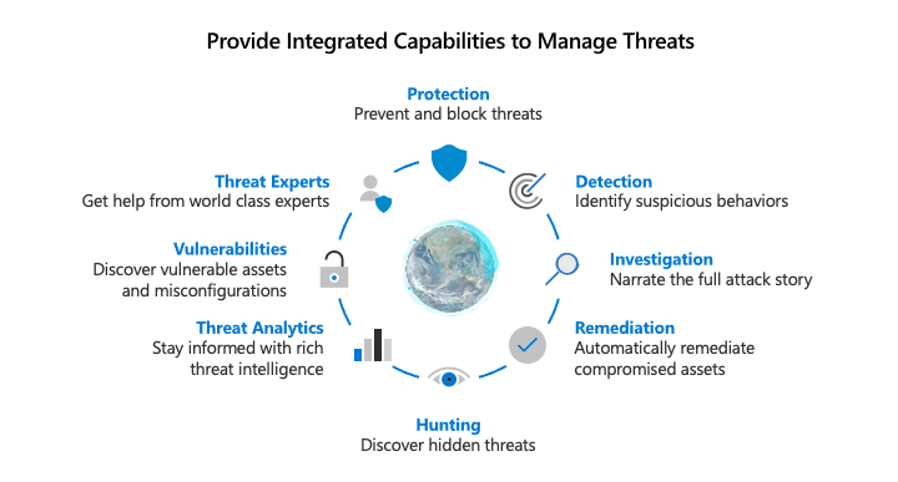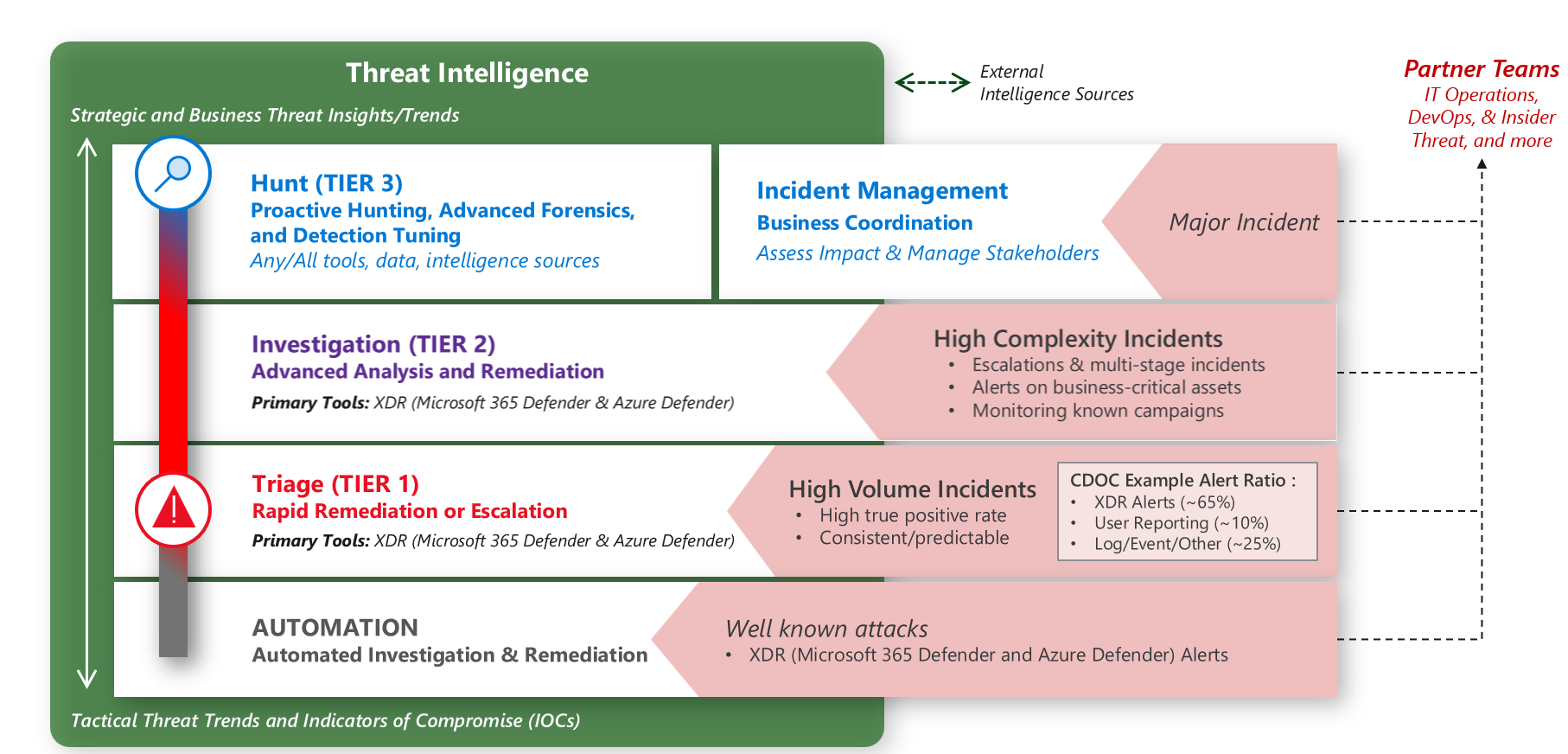Introduction to Security operations (SecOps)
This module covers the topic of designing security operations solutions in hybrid, multicloud, and edge environments, focusing on Microsoft's solutions for cloud security, extended detection and response (XDR), and Security Information and Event Management (SIEM).
Imagine you're a cybersecurity architect in a large organization that operates in a hybrid, multicloud, and edge environments. You're facing challenges in managing operations consistently across different cloud providers, which is leading to increased costs and strain on your team. You also need to enhance your organization's security posture by implementing advanced cybersecurity solutions and automating incident response processes. This module guides you through the process of implementing unified operations and enhancing security using Microsoft's solutions.
Learning objectives
In this module, you learn how to:
- Design security operations capabilities in hybrid and multicloud environments
- Design centralized logging and auditing
- Design Security Information and Event Management (SIEM) solutions
- Design a solution for detection and response that includes Extended Detection and Response (XDR)
- Design a solution for security orchestration, automation, and response (SOAR)
- Design security workflows
- Design and evaluate threat detection with the MITRE ATT&CK framework
The content in the module helps you prepare for the certification exam SC-100: Microsoft Cybersecurity Architect.
Prerequisites
- Advanced experience and knowledge in identity and access, platform protection, security operations, securing data, and securing applications.
- Experience with hybrid and cloud implementations.
Introduction to security operations (SecOps)
The main objective of a cloud security operations (SecOps) function is to detect, respond to, and recover from active attacks on enterprise assets.
As SecOps matures, security operations should:
- Reactively respond to attacks detected by tools
- Proactively hunt for attacks that slipped past reactive detections
Security Operations strategy overview
One of the significant changes in perspectives that are a hallmark of a Zero Trust security framework is moving away from trust-by-default toward trust-by-exception. However, this still requires a reliable way to establish trust once trust is needed. Since you no longer assume that requests are trustworthy, establishing a means to attest to the trustworthiness of the request is critical to proving its point-in-time trustworthiness. This attestation requires gaining visibility into the activities on and around the request.
All these investments increase your visibility, which gives you better data for making trust decisions. However, adopting a Zero Trust approach in other areas like identities, endpoints, infrastructure, and networks, increases the number of incidents Security Operation Center (SOC) analysts need to mitigate.

With each of these individual areas generating its relevant alerts, an integrated capability is needed to manage the resulting influx of data to better defend against threats and validate trust in a transaction.
Security operations functions
Security operations teams often focus on three key outcomes:
- Incident management: Manage active attacks on the environment, including:
- Reactively responding to detected attacks.
- Proactively hunting for attacks that slipped through traditional threat detections.
- Coordinating the legal, communications, and other business implications of security incidents.
- Incident preparation: Help the organization prepare for future attacks. Incident preparation is a broader strategic set of activities that are aimed at building muscle memory and context at all levels of the organization. This strategy prepares people to better handle major attacks and gain insights on security process improvements.
- Threat intelligence: Gathering, processing, and disseminating threat intelligence to security operations, security teams, security leadership, and business leadership stakeholders through security leadership.
To deliver against these outcomes, security operations teams should be structured to focus on key outcomes. In larger SecOps teams, the outcomes are often broken out between subteams.
- Triage (tier 1): The frontline of response for security incidents. Triage is focused on the high-volume processing of alerts, and typically generated by automation and tools. The triage processes solve for most of common incident types and resolve them within the team. More complex incidents, or new types of incidents, should be escalated to tier 2.
- Investigation (tier 2): Focused on incidents that require further investigation, often requiring correlation of data points from multiple sources. This investigation tier looks to provide repeatable solutions to issues escalated to them. It then enables tier 1 to resolve later recurrences of that issue type. Tier 2 also responds to alerts against business critical systems, to reflect the severity of the risk and the need to act quickly.
- Hunt (tier 3): Focused primarily on proactive hunting for highly sophisticated attack processes and developing guidance to the wider teams for maturing security controls as a result. The tier 3 team also acts as an escalation point for major incidents in to support forensic analysis and response.
Modernization
Detecting and responding to threats is currently undergoing significant modernization at all levels.
- Elevation to business risk management: SOC is growing into a key component of managing business risk for the organization
- Metrics and goals: Tracking SOC effectiveness is evolving from "time to detect" to these key indicators:
- Responsiveness via mean time to acknowledge (MTTA).
- Remediation speed via mean time to remediate (MTTR).
- Technology evolution: SOC technology is evolving from exclusive use of static analysis of logs in a SIEM to add the use of specialized tooling and sophisticated analysis techniques. This provides deep insights into assets that provide high quality alerts and investigation experience that complement the breadth view of the SIEM. Both types of tooling are increasingly using AI and machine learning, behavior analytics, and integrated threat intelligence to help spot and prioritize anomalous actions that could be a malicious attacker.
- Threat hunting: SOCs are adding hypothesis driven threat hunting to proactively identify advanced attackers and shift noisy alerts out of frontline analyst queues.
- Incident management: Discipline is becoming formalized to coordinate nontechnical elements of incidents with legal, communications, and other teams. Integration of internal context: To help prioritize SOC activities such as the relative risk scores of user accounts and devices, sensitivity of data and applications, and key security isolation boundaries to closely defend.
Team composition and key relationships
The cloud security operations center is commonly made up of the following types of roles.
- IT operations (close regular contact)
- Threat intelligence
- Security architecture
- Insider risk program
- Legal and human resources
- Communications teams
- Risk organization (if present)
- Industry specific associations, communities, and vendors (before incident occurs)
